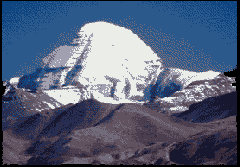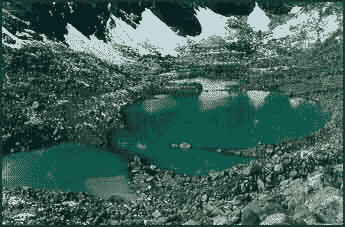| Trekking
Trip Planning: Kailash Mansarovar |
|||||||||
Mount Kailash at 22,022 feet is one of the highest peaks in the region. The trek involves a 3-day circumambulation of 52 kms around Mount Kailash, reaching a height of 19,200 feet at the Dolma Pass. It is also possible to undertake another 3-day circumambulation of Lake Manasarovar at 15,000 feet. The Brahmaputra, Indus, Sutlej and the Karnali all have their source in the plateau where Kailash dominates. Originating from the roof of the world they merge in the oceans, 1500 miles apart. The Brahmaputra enters the Bay of Bengal in the east of the subcontinent and the Indus unites with the Arabian Sea in the west. This is a high altitude trek with a wide variety of landscapes, adventure and experiences. There are river crossings, high passes and incredible views. There is the lunar beauty of the Tibetan landscape, the luminosity of the air and the realisation that this is one of the most barren and desolate regions of the world. In this remote trans-Himalayan region of western Tibet, Kailash stands alone in solitary splendour. Not part of a range, its isolation makes it possible to go around it, customarily in a period of 3 days. |
More on Tibet • FAQ on Kailash
Trekking
Pilgrimages
Mountaineering
| ||||||||
Possible Routes
There are 3 ways to reach Mount Kailash from India.
2) By air to Kathmandu and from there by road to Lake Manasarovar at the base of Mount Kailash. Nepal Airways has flights from Mumbai to Kathmandu. They are not particularly renowned for reliability. Flights are often delayed or cancelled. Most travellers prefer to take Indian Airlines from Delhi. This has become the most popular route. 3). 9 & 12 day helicopter tours of Kailash for those who are short of time or cannot take the rigours of a grueling high altitude road journey. The tour uses fixed wing aircraft for the flight from Kathmandu to Nepalganj and from there to Simikot. From Simikot a helicopter flies to Hilsa. Landcruisers are then used to reach Manasarovar via Lhasa. Highlights of the Trip The 17-day tour via Kathmandu includes 3 days at Kathmandu, including 2 half-day sight-seeing tours. In the meantime, the visa formalities are completed. The road journey across Nepal to the foothills of Mount Kailash takes five days. Like all treks and journeys in remote inaccessible regions, there is ample scope for the unexpected. Landslides and other impediments do occur with reasonable frequency. Night halts are organised in tents at camping sites along the way. Buses take one from Kathmandu to the place where the Toyota Land cruisers wait. The roads are un-metalled and the journey is dusty, fairly exhausting and a strain on the back. One can expect to experience varying degrees of high altitude sickness. There are medicines to contain the effects and one generally acclimatises in 48 hours. The one thing that keeps you going is the desire to reach Kailash and Manasarovar. There is a full day reserved for Lake Manasarovar, but no parikrama is included in this itinerary. Trips can, however, be tailor made for longer stay for a minimum group size of 10 people.
The first day's trek is an 18 km trek to Dhira Puk and takes 7 to 8 hours. This is mainly flat ground and one traverses it keeping Mount Kailash on the right side. The giant black rock stands out sharply in stark contrast to its surroundings. Dhira Puk offers one of the best views of Kailash. The second day is arduous, and the 22 km, high altitude trek to Zuthul Puk takes 7 to 8 hours to complete. On the way, one crosses the famous Dolma pass at 19,500 ft. where it is believed that the body of the pilgrim transforms itself into a celestial body. The weather can be unpredictable and one might encounter drizzle, or snowstorms. As one descends Dolma Pass one sees the emerald pure waters of Gouri Kund. This is believed to be the exclusive bathing place of Goddess Parvati. At 18,400 feet it is probably the highest in the world. From Dolma pass to the valley below is a steady descent followed by a flat trek. Zuthul Puk to Tarchen is an easy trek of 14 kms and can be completed in 4 hours. One finishes the trek knowing that one has circumambulated the known universe. Stripped of everything superfluous, the earth reveals itself in various shades of blue, red and orange, unchanged since the times these mountains were thrust up into existence. The primeval beauty of the landscape is like no other. The pure mountain air gives an aura of other worldliness and intensity. The drive back to Kathmandu is a return to civilization.
Photo Credit: Sumanta Roy Chowhury
|
|||||||||
Editor: Romola Butalia (c) India Travelogue. All rights reserved. |
|||||||||
 1) By road from India. The Government of India organises tours to Lake Manasarovar. This is a 30 day trek but the disadvantage is that it has to be booked well in advance and there is no certainty that one can go despite being in physical shape, because the number of seats is limited. About 400 people make it from the 6000 that apply each year.
1) By road from India. The Government of India organises tours to Lake Manasarovar. This is a 30 day trek but the disadvantage is that it has to be booked well in advance and there is no certainty that one can go despite being in physical shape, because the number of seats is limited. About 400 people make it from the 6000 that apply each year. The journey into the Land of the Gods commences through a small gateway; Yama Dwar named after Yama, the Lord of Death. The symbolic significance is huge and is a reminder of the Katha Upanishad where Nachiketas waited for 3 days at Yama's door to be enlightened.
The journey into the Land of the Gods commences through a small gateway; Yama Dwar named after Yama, the Lord of Death. The symbolic significance is huge and is a reminder of the Katha Upanishad where Nachiketas waited for 3 days at Yama's door to be enlightened.